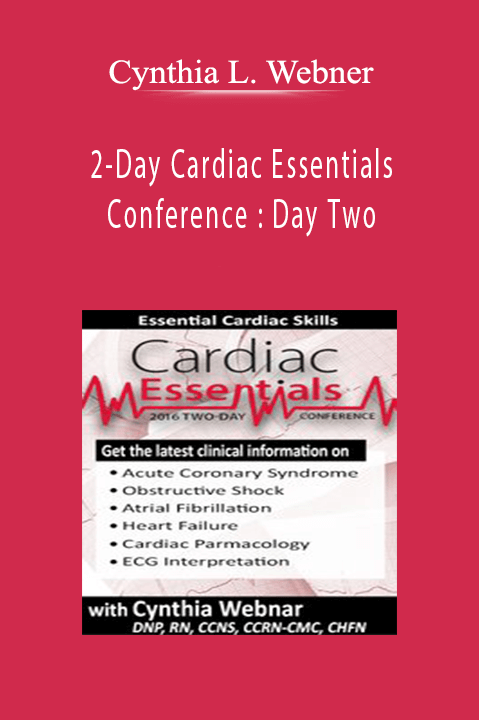ECG & Arrhythmia Interpretation Made Easy – Cynthia L. Webner
- Take the Fear and Intimidation out of ECG Interpretation!
- Quickly and Confidently Identify Changes in a Patient’s Cardiac Status
- Step-by-Step Systematic Approach GUARANTEED to Improve Your Skills
- Don’t Miss this Opportunity to Become a Cardiac Expert
The ECG is the most commonly-used procedure for diagnosing a wide variety of cardiac conditions, yet even the most seasoned nurses struggle to master interpretation. Attend this seminar and finally learn to recognize borderline and abnormal tracings. In this information-packed program expert, Cynthia L. Webner, will teach you easy-to-understand techniques to identify acute coronary syndromes, bundle branch blocks and challenging rhythms you would have previously missed. Through hands-on practice, learn how to look at and analyze:
- QRS axis to help determine diagnosis
- Contrast left anterior and posterior hemiblocks
- Recognize the location of acute coronary syndromes
- Differentiate LBBB versus RBBB and their significance
- Find chamber enlargements
- And most importantly, respond to the patient emergencies associated with each of these changes!
- Choose correct electrode placement required for accurate 12-lead ECG acquisition.
- Assess normal and abnormal patterns on each lead of the 12-lead ECG.
- Determine cardiac axis using lead I and aVF.
- Analyze the 12-lead ECG features seen in atrial and ventricular hypertrophy.
- Specify the features of right bundle branch block from the features of left bundle branch block.
- Evaluate patterns of infarct, injury, and ischemia on the 12-lead.
- Utilize morphology in Lead V1 and V6 to differentiate ventricular tachycardia from SVT with aberrant conduction.
- Categorize high risk features for Torsades de Pointes and other cardiac arrhythmias.
Time Saving Tips & Strategies
- Systematic Approach
- Correlating Cardiac Conduction with Waveforms
- Layout of the 12-Lead, 15-Lead & Right-sided ECG
- Positive & Negative Lead Placement
- Cardiac Conduction System Clues
Determining Cardiac Axis
- Quick Approach for Axis by Quadrant
- Axis Practice Utilizing “Thumbs Technique”
- Causes for Axis Deviation
- Axis in Disease Diagnosis
Conduction Abnormalities
- Right & Left BBB Morphology
- Left Anterior Hemi-Block Criteria
- Chamber Enlargement
- Atrial Hypertrophy
- Right- & Left-Ventricular Hypertrophy
Myocardial Injury and Ischemia
- Patterns of Injury & Ischemia
- ST Segment & T Wave Changes
- Reciprocal Changes
- Pathological Q waves
- Specific Types of Myocardial Infarction
- Subtle Clues
Complex Arrhythmia Interpretation
- Mechanisms of Tachyarrhythmias
- Evaluating Wide Complex Tachycardias
- VT versus SVT with BBB Aberrancy
High Risk Features
- QT abnormalities
- The Brugada Syndrome
- Wolff Parkinson White Syndrome
Putting It All Together
- Emergency Interventions
- Acute vs. Chronic Treatment Recommendations
- Documentation of Findings
Instant Access Available
Downloadable Content

Get Instant Access ECG & Arrhythmia Interpretation Made Easy – Cynthia L. Webner at Offimc.click Now!
Sale Page: https://catalog.pesi.com/item/28043/
Delivery Information
- Upon ordering the product, a delivery email with download instructions will be sent immediately to you so that you may download your files. If you log in (or create an account) prior to purchase you will also be able to access your downloads from your account dashboard.
- It is a digital download, so please download the order items and save them to your hard drive. In case the link is broken for any reason, please contact us and we will resend the new download link to you.
- If you don't receive the download link, please don’t worry about that. We will update and notify you as soon as possible from 8:00 AM – 8:00 PM (UTC+8).
- Please Contact Us if there are any further questions or concerns you may have. We are always happy to assist!


















6 reviews for Cynthia L. Webner – ECG & Arrhythmia Interpretation Made Easy
There are no reviews yet.